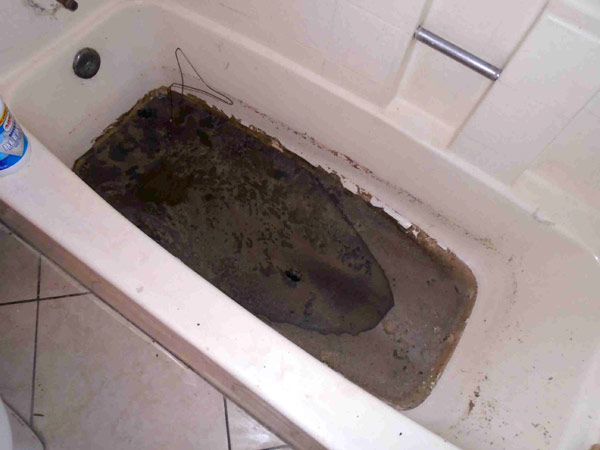Essential Factors Behind Waste in the Bathtub
Essential Factors Behind Waste in the Bathtub
Blog Article
We've stumbled on the article relating to What to Do if Sewage Starts Coming Up Through Your Bathtub listed below on the internet and thought it made sense to write about it with you on this site.

Sewer back-up in the bathtub can be a stressful and unsanitary issue for any kind of homeowner. Not just is it troublesome, however it additionally poses major health risks and indicates underlying problems with the plumbing system. Recognizing why sewer is showing up with the bathtub is important for taking appropriate activity to address the trouble efficiently.
Introduction to the Problem
Recognizing the Problem
When sewer draws back up right into the bathtub, it's a clear sign of a problem with the drain system. The wastewater that needs to be streaming away from your home is instead discovering its way back into your living space, which can result in considerable damage and carcinogen.
Potential Causes
Numerous elements can add to sewer back-up in the bathtub. From clogs in the sewer line to issues with the plumbing facilities, determining the root cause is crucial for discovering an option.
Common Factors for Sewage Back-up
Clogs in the Sewer Line
Among the most common reasons for sewage backup is a clog in the sewer line. This can occur as a result of the buildup of debris, oil, or foreign things in the pipelines, avoiding proper circulation and triggering sewage to back up into your bath tub.
Tree Origin Breach
Tree roots looking for dampness and nutrients can infiltrate drain lines with tiny fractures or joints. Over time, these origins can expand and expand, triggering considerable damage to the pipes and bring about sewer backup concerns.
Aging Facilities
Older homes may have obsoleted plumbing systems that are more susceptible to corrosion, splits, and degeneration. As pipes age, they become extra susceptible to leaks and obstructions, boosting the possibility of sewage backup occurrences.
Heavy Rainfall or Flooding
Throughout periods of heavy rainfall or flooding, the sewer system may come to be overloaded with excess water, triggering backups and overflows. This can result in sewer supporting into bathtubs and various other fixtures inside the home.
Health Risks Connected With Sewer Back-up
Contamination of Water
Sewage backup can contaminate the water in your house, positioning a serious health and wellness threat to you and your household. Exposure to infected water can cause intestinal concerns, skin infections, and other ailments.
Spread of Disease
Sewage includes unsafe bacteria, viruses, and bloodsuckers that can trigger a series of conditions, consisting of liver disease, cholera, and gastroenteritis. Entering contact with sewer or infected surfaces puts you at risk of infection.
Mold Growth
Moisture from sewage backup can create perfect problems for mold development in your house. Mold and mildew spores can intensify breathing troubles and cause allergies in sensitive people, making punctual clean-up vital.
Signs of Sewer Back-up
Foul Odors
Undesirable smells emanating from drains pipes or fixtures, specifically in the restroom, may show sewer backup problems. These odors are typically strong and persistent, indicating a problem that needs prompt focus.
Slow Draining Fixtures
Tubs, sinks, and bathrooms that drain pipes gradually or not at all could be experiencing sewage back-up. If several components are influenced all at once, it's most likely that the concern stems from an usual factor, such as the primary sewer line.
Gurgling Noises
Strange gurgling or bubbling noises originating from drains when water is running somewhere else in your house are a measure of air entraped in the plumbing system. This air buildup can result from sewer backup and ought to be investigated immediately.
Immediate Actions to Take
Shutting Off Water Supply
In the event of sewage back-up, it's vital to turn off the water to stop additional contamination and damages. Locate the main water shutoff valve in your home and closed it off until the concern can be dealt with.
Getting In Touch With an Expert Plumber
Handling sewage back-up is not a do it yourself task. Get in touch with an accredited plumber with experience in handling sewage-related problems to assess the situation and carry out needed repairs or cleanups.
Staying Clear Of Contact with Infected Water
Till the sewage backup is dealt with, prevent contact with polluted water to avoid the spread of germs and virus. Use safety equipment if you should be in the damaged location and clean your hands thoroughly afterward.
Preventive Measures
Regular Upkeep of Sewage System Lines
Schedule routine assessments and maintenance of your drain lines to identify and address prospective concerns prior to they intensify into significant issues. This can include clearing out particles, inspecting for tree origin intrusion, and repairing any kind of damaged pipelines.
Installing Bayou Valves
Take into consideration installing bayou valves in your plumbing system to stop sewage from receding into your home during periods of heavy rainfall or flooding. These shutoffs immediately close when water draws back up, protecting your residential property from contamination.
Correct Disposal of Household Waste
Stay clear of purging anything other than toilet paper and human waste down the bathroom to stop clogs and blockages in the drain line. Dispose of grease, oil, and other home chemicals effectively to minimize the threat of plumbing problems.
Cleaning Up After Sewage Back-up
Sanitation Procedures
Thoroughly decontaminate and sanitize impacted locations after sewer backup to remove hazardous bacteria and avoid mold growth. Use proper cleansing items and safety equipment to guarantee secure and reliable cleaning.
Restoration of Influenced Areas
Repair any damage to flooring, wall surfaces, or components brought on by sewer back-up. Depending upon the extent of the damages, you might need to change carpets, drywall, or various other products to restore your home to its pre-loss condition.
Why Is Water Backing Up in My Bathtub When I Flush My Toilet?
What to do about a sewer line clog
First, don’t bother with plunging. No amount of plunging will dislodge the clog in a sewer line. The clog is too far away. Plungers are for clogs in the toilet itself, not the sewer line. Plus, the most likely causes of a sewer clog are:
Tree roots Flushed toys or feminine products Grease buildup Those items don’t move easily. And in the case of tree roots, the roots need to be cut out of the pipe and the pipe will need to be repaired.
You’ll need a closet auger. A closet auger is a type of plumber’s snake with a protective cover to keep from scratching the delicate porcelain toilet. If the clog is further down, you may need to remove the toilet or use one of your cleanouts to get to the clog.
We also recommend doing a video inspection of the drain to ensure that the cause of the clog has been completely removed. Otherwise, you could have the same problem again in a few days or weeks.
https://mspplumbingheatingair.com/blog/why-is-water-backing-up-in-my-bathtub-when-i-flush-my-toilet

I am very serious about What To Do If Sewage Starts Backing Up Into the Shower and I'm hoping you enjoyed reading the new blog entry. Are you aware of another person who is intrigued by the niche? Please feel free to promote it. Many thanks for taking the time to read it.
Call Today
Report this page